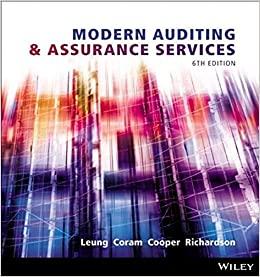You are the audit senior on the MM Ltd audit. MM is a distributor of hair care
Question:
You are the audit senior on the MM Ltd audit. MM is a distributor of hair care products including shampoos, conditioners and mousses. MM uses an online computer system. No goods are manufactured in-house; rather, MM maintains a stock of raw materials and subcontracts the manufacture of its products to third parties. Approximately 50 suppliers and subcontractors are used, and all have proven to be reliable. You have made the following notes about the inventory system.
1. Separate systems, staff and warehouses are maintained for both finished goods and raw materials.
Procedures for raw materials
1. Purchase orders are automatically generated by the computer when stocks of any raw material fall below 70% of the previous month's usage. The purchase orders contain the date, the supplier's name and address, and the raw materials needed. Three copies are produced and distributed to:
◦ the warehouse to enable follow-up of late orders
◦ the accounts clerk for filing by date order
◦ the supplier.
2. When raw materials stock is received, the barcode attached to the delivery boxes by the supplier is scanned into the system. A two-part receiving report is produced that is:
◦ matched to the warehouse copy of the order by stores staff
◦ filed by the accounts clerk.
3. The scanning process is aborted if the codes do not match those on the master file.
Procedures for finished goods
1. Purchase orders are automatically generated when finished goods fall below 60% of the previous month's sales. The production orders contain the date, the subcontractor's name, the raw materials required and the finished goods needed. Two copies are produced and distributed to:
◦ the raw materials store for use as a picking slip, and then packed with the goods and sent to the subcontractor
◦ the production controller to be filed in date order.
2. When the finished goods stocks are received, the barcodes attached to the delivery boxes by the subcontractor are scanned into the system. A two-part receiving report is produced that is:
◦ matched to the production controller's copy of the order
◦ filed by the accounts clerk.
3. The scanning process is aborted if the codes do not match those on the master file.
General notes
1. The computer automatically selects the supplier/subcontractor of both raw materials and finished goods based on the latest price (as per their most recent invoice) and their delivery times (based on the number of days between the date on which the purchase/production order is raised and the date on which the goods are scanned by the warehouse).
Password access is as follows:
Stores staff (raw materials) Purchase order printing for raw materials only Receiving report printing for raw materials Stores staff (finished goods) Receiving report printing for finished goods Production controller Production order printing; master file amendments Accounts clerk Master file amendments Master file amendments 1. The stock master file contains details of existing stock items, including the code and warehouse location, and approved suppliers and subcontractors.
2. Orders will be generated only to the suppliers and subcontractors recorded on the master file.
3. Master file changes are made by the production controller for both the raw materials inventory and the finished goods inventory. A master file amendment form is completed by the production controller as a record of the changes made.
Required
a. Identify any weaknesses in the internal controls described. Discuss the implications of each weakness you identify.
b. Assume your computer information system audit division is to perform testing of controls for the inventory systems described. Identify key controls that you would recommend for testing.
c. Assuming the use of generalized audit software, list the procedures/reports you would ask the computer information system auditors to run to help you test the valuation of inventory.
Step by Step Answer:

Modern Auditing And Assurance Services
ISBN: 9781118615249
6th Edition
Authors: Philomena Leung, Paul Coram, Barry J. Cooper, Peter Richardson





